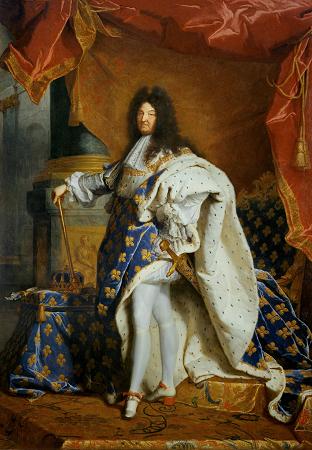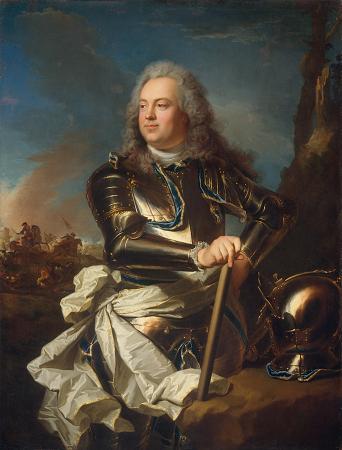Hyacinthe Rigaud (1659 - 1743). Jacint Rigau-Ros i Serra, known as Hyacinthe Rigaud, was a French baroque painter most famous for his portraits of Louis XIV and other members of the French nobility. Hyacinthe Rigaud was born in Perpignan, the grandson of painter-gilders from Roussillon and the elder brother of another painter. He was trained in tailoring in his father's workshop but perfected his skills as a painter under Antoine Ranc at Montpellier from 1671 onwards, before moving to Lyon four years later. It was in these cities that he became familiar with Flemish, Dutch and Italian painting, particularly that of Rubens, Van Dyck, Rembrandt and Titian, whose works he later collected. Arriving in Paris in 1681, he won the prix de Rome in 1682, but on the advice of Charles Le Brun did not make the trip to Rome to which this entitled him. Received into the Académie royale de peinture et de sculpture in 1710, he rose to the top of this institution before retiring from it in 1735. Since Rigaud's paintings captured very exact likenesses along with the subject's costumes and background details, his paintings are considered precise records of contemporary fashions. Rigaud was born with the Catalan name Jyacintho Rigau or Jacint Rigau i Ros This is variously translated as Híacint Francesc Honrat Mathias Pere Martyr Andreu Joan Rigau-in Perpignan, which became part of France by the Treaty of the Pyrenees shortly after his birth. Rigaud was baptised with his Catalan name in the old cathédrale Saint-Jean de Perpignan on 20 July 1659, two days after his birth at rue de la Porte-d'Assaut. He would not have become French had not Roussillon and the Cerdanya been annexed to France the following 7 November thanks to the Treaty of the Pyrenees. That Treaty also put an end to the wars that had taken place between France and Habsburg Spain since 1635 and married King Louis XIV of France to the infanta Maria Theresa of Spain. Hyacinthe's father, Josep Matias Pere Ramon Rigau, was a tailor in the parish of Saint-Jean de Perpignan, as well as a painter, descended from a line of well-established artists in the Perpignanian basin who had been commissioned to decorate several tabernacles and other panels for liturgical use. Few of these have survived to the present. Hyacinthe's grandfather, Jacinto major, and even more Jacinto's father, Honorat minor, were heads of the family and the local art world from 1570 to 1630; probably as much as gilders as painters, since in their studios were to be found many prints and books treating on the art of painting, and other things, such as brushes and palettes for painting. Working for the collège Saint-Éloi in his city since 1560, and acting as representative of its guild of painters and gilders, on 22 November 1630 Jacinto major and other gilders and colleagues participated in the development of the statutes and minutes of the city's collège Saint-Luc. Honorat minor is generally identified as the painter of The Canonisation of Saint Hyacinthe, formerly in Perpignan's Dominican convent and now at Joch, the tabernacle of the church of Palau-del-Vidre and the retable at Montalba near Amélie-les-Bains. The father of Honorat minor is generally identified as the painter of the retable of Saint-Ferréol in the église Saint-Jacques de Perpignan and formerly in the couvent des Minimes, whilst Honorat major is usually identified as the painter of the paintings of the retable of the église Saint-Jean-l'Évangéliste at Peyrestortes. On 13 March 1647 Hyacinthe's father Matias Rigau, married Thérèse Faget, daughter of a carpenter. Widowed shortly after, he decided to speedily remarry, to Maria Serra, daughter of a Perpignan textile merchant, on 20 December 1655. In 1665, he acquired a house en lo carrer de las casas cremades and received the income from a parcel of vineyards in the Bompas territory. By his second marriage, he also acquired a house on place de l'Huile, but he soon sold it. Unfortunately, little is known about Rigaud's activities in Lyon, due to the lack of surviving documents. However, as per tradition, artists from Montpellier had strong ties with this city, as had, for example, Samuel Boissière who was trained in there, in Lyon. The identity of Rigaud's future depicted models shows that he worked for the city's cloth merchants, whose flourishing trade had long since given the city its profitable income. Even if they had only been registered from 1681 onwards, the date when he moved to Paris, his youthful portraits were probably pre-dated, like those of Antoine Domergue, the king's councillor and provincial governor of Lyon, in 1686, and Mr Sarazin de Lion, of a famous dynasty of bankers of Swiss origins, in 1685.
more...














